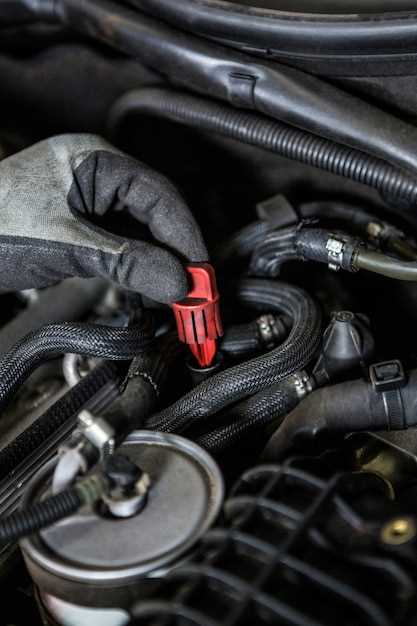
Replacing spark plugs is a crucial maintenance task that every vehicle owner should be aware of. Spark plugs play a vital role in the engine’s combustion process, igniting the air-fuel mixture and ensuring smooth operation. Over time, these essential components can wear out, leading to various performance issues and reduced fuel efficiency.
Understanding the reasons for spark plug replacement is fundamental for maintaining your vehicle’s performance. Factors such as age, mileage, and engine type can affect the longevity of spark plugs. Additionally, signs like rough idling, decreased acceleration, and increased fuel consumption are strong indicators that it’s time to consider a replacement.
Knowing when to replace your plugs can save you from costly repairs and improve your vehicle’s overall performance. Regular inspection and replacement based on manufacturer recommendations can prevent potential issues and ensure that your engine runs smoothly. This guide will provide key insights into the timing and importance of spark plug replacement, helping you keep your vehicle in optimal condition.
Common Signs Indicating Spark Plug Replacement
Regular maintenance of your vehicle is crucial, and spark plugs play a significant role in engine performance. Here are common signs that indicate it may be time to replace your spark plugs:
- Engine Misfires: A misfiring engine is a clear indication that the spark plugs may not be firing correctly. This can lead to rough idling and decreased acceleration.
- Poor Fuel Economy: If you notice that your vehicle is using more fuel than usual, worn spark plugs could be a contributing factor. Inefficient combustion can significantly impact fuel consumption.
- Difficulty Starting the Engine: Trouble starting your vehicle can stem from faulty spark plugs. If the engine cranks but doesn’t start smoothly, it’s worth checking the spark plugs.
- Illuminated Check Engine Light: An illuminated check engine light can indicate various issues, including spark plug failure. Diagnostic tools can help confirm if the spark plugs are to blame.
- Unusual Engine Noise: Strange sounds, such as knocking or pinging, can occur when spark plugs are not functioning properly, affecting engine combustion.
- Excessive Engine Vibration: If the engine appears to vibrate or shake more than usual, it may be a sign that the spark plugs are not firing consistently.
- Visual Inspection: Signs of damage or wear, such as buildup of carbon deposits on the spark plugs, or eroded electrodes are indicators that replacement is necessary.
Addressing these issues promptly by replacing spark plugs can enhance vehicle performance and prolong engine life.
Recommended Timing for Spark Plug Changes based on Vehicle Type

Regular maintenance is crucial for vehicle performance, with spark plugs serving as a vital component in engine operation. The recommended timing for changing spark plugs varies depending on the type of vehicle you own.
Gasoline Engines: For most gasoline engines, it is advisable to replace spark plugs every 30,000 to 50,000 miles. Older vehicles, especially those with conventional ignition systems, may require more frequent replacements within this range due to wear and carbon buildup.
High-Performance Engines: Vehicles designed for high performance often have specific spark plug requirements. These plugs may need replacement every 20,000 to 30,000 miles to maintain engine efficiency and power output. Regular inspection is essential, as plugs can deteriorate faster under high-stress conditions.
Diesel Engines: Diesel engines generally experience less wear on spark plugs due to differences in combustion. As a result, changing plugs every 60,000 to 100,000 miles is typically sufficient. However, it is crucial to follow the manufacturer’s guidelines for specific vehicle recommendations.
Hybrid Vehicles: Hybrid vehicles, which utilize both an electric motor and a gasoline engine, often have longer intervals between spark plug changes. These vehicles usually require replacements every 100,000 miles, thanks to the reduced reliance on the internal combustion engine.
In all cases, consulting the vehicle owner’s manual and considering driving conditions can help determine the best timing for spark plug changes. Regularly checking the condition of spark plugs can prevent engine misfires and improve overall efficiency.
Step-by-Step Guide to Replacing Spark Plugs Yourself

Replacing spark plugs is an essential maintenance task that can improve engine performance and fuel efficiency. Follow this step-by-step guide to successfully perform the spark plug replacement yourself.
Step 1: Gather Necessary Tools and Materials
Before starting, ensure you have the following tools: a ratchet wrench, spark plug socket, torque wrench, extension bar, and a gap gauge. Additionally, have the replacement spark plugs ready, as well as some anti-seize compound for added protection.
Step 2: Prepare the Engine
Ensure the engine is cool to prevent burns. Disconnect the battery to avoid any electrical issues during the replacement process. If necessary, remove any components that obstruct access to the spark plugs, such as engine covers or air intake ducts.
Step 3: Remove Old Spark Plugs
Using the ratchet wrench and the spark plug socket, carefully unscrew each spark plug. Turn counterclockwise to loosen. Take note of the spark plug’s condition, as it may indicate engine issues. Place the old plugs aside for comparison.
Step 4: Prepare New Spark Plugs
Before installation, check the gap on each new spark plug using the gap gauge. Adjust the gap according to your vehicle specifications. Apply a small amount of anti-seize compound to the threads of the new plugs to ensure they can be removed easily in the future.
Step 5: Install New Spark Plugs
Carefully insert each new spark plug into the socket and hand-tighten it into place. Use the torque wrench to tighten each spark plug to the manufacturer’s recommended torque specification. Be cautious not to overtighten, as this can damage the threads.
Step 6: Reassemble and Reconnect
Once all new plugs are installed, reattach any components you removed earlier. Reconnect the battery, ensuring all connections are secure. Double-check that everything is in place before starting the engine.
Step 7: Start the Engine
Start the engine and listen for any irregular sounds. If the engine runs smoothly, the replacement was successful. Monitor the vehicle’s performance and fuel efficiency over the next few days to ensure everything is functioning properly.
By following these steps, you can confidently complete a spark plug replacement on your own, enhancing your vehicle’s performance and ensuring its longevity.




